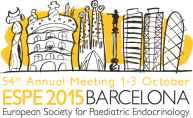
54th Annual ESPE
Barcelona,
Spain
01 Oct 2015 - 03 Oct 2015
Poster Presentations Poster Category 1
Perinatal
hrp0084p1-100 | Perinatal | ESPE2015
Atypical Features in Patients with Leprechaunism Suggesting a Wide Clinical Spectrum of Disease
Katugampola Harshini , Improda Nicola , Shah Pratik , Gordon Hannah , Amin Rakesh , Peters Catherine J , Semple Robert K , Dattani Mehul T
hrp0084p1-101 | Perinatal | ESPE2015
Does Type 1 Childhood Diabetes Start In Utero?
Laron Zvi , Hampe Christiane , Shulman Lester
hrp0084p1-102 | Perinatal | ESPE2015
The Role of HNF1B in Human Pancreas Development and Diabetes
El Khairi Ranna , Hattersley Andrew , Vallier Ludovic
hrp0084p1-103 | Perinatal | ESPE2015
Molecular Characterization of a Novel Non-stop KCNJ11 Mutation Associated with a Dual Focal and Diffuse Hyperinsulinaemic Hypoglycaemia Phenotype
Arya Ved Bhushan , Aziz Qadeer , Flanagan Sarah E , Ellard Sian , Tinker Andrew , Hussain Khalid
hrp0084p1-104 | Perinatal | ESPE2015
Diazoxide Responsive Congenital Hyperinsulinism in a Patient with Dual Genetic Aetiology (HNF4A and ABCC8 Mutation)
Giri Dinesh , Flanagan Sarah E , Park Julie , Ellard Sian , Didi Mo , Sennaippan Senthil
hrp0084p1-105 | Perinatal | ESPE2015
Fluoxetine Induced Hypoglycaemia in a Patient with Congenital Hyperinsulinism on Lanreotide Therapy
Giri Dinesh , Yung Zoe , Stirrup Kelly , Didi Mo , Seniappan Senthil
hrp0084p1-106 | Perinatal | ESPE2015
Influence of Nocturnal Glycaemia on Ventricular Repolarisation and Heart Rate Variability in Prepubertal Children with Type 1 Diabetes
Saade Marie-Beatrice , Pecquet Aurelien , Pladys Patrick , Beuchee Alain , Pele Fabienne , Nivot Sylvie , de Kerdanet Marc
hrp0084p1-107 | Perinatal | ESPE2015
Changes in Serum Protein Expression in Small-for-Gestational-Age Newborn Infants at Different Gestational Ages
Canete Ramon , Ruiz-Gonzalez Maria Dolores , Canete Maria Dolores , Gomez-Chaparro Jose Luis , Abril-Diaz Nieves , Lopez-Barea Juan Luis
hrp0084p1-108 | Perinatal | ESPE2015
Liver ER Stress and Intrauterine Growth Retardation in Rats
Deodati Annalisa , Argemi Josepmaria , Puglianiello Antonella , Germani Daniela , Ferrero Roberto , Aragon Tomas , Cianfarani Stefano
hrp0084p1-109 | Perinatal | ESPE2015
Continuous Subcutaneous Infusion of Recombinant LH and FSH During Early Infancy Promotes Testicular Descent in Congenital Hypogonadotropic Hypogonadism
Lambert Anne Sophie , Lucchini Philippe , Bouvattier Claire , Bougneres Pierre
hrp0084p1-110 | Perinatal | ESPE2015
Neonatal Screening Program for Central Congenital Hypothyroidism
Braslavsky Debora , Prieto Laura , Keselman Ana , de Papendieck Laura Gruneiro , Enacan Rosa , Mendez Virginia , Bergada Ignacio , Chiesa Ana



